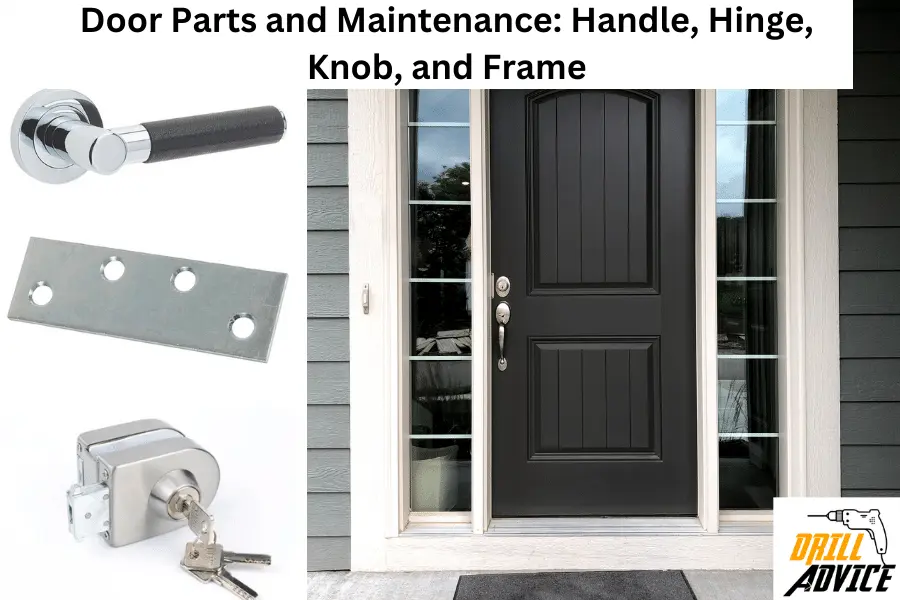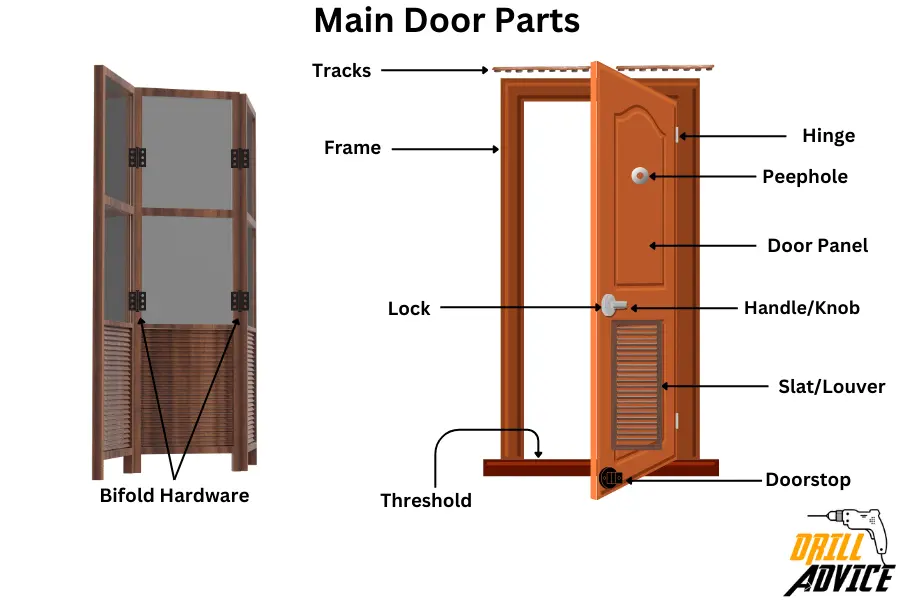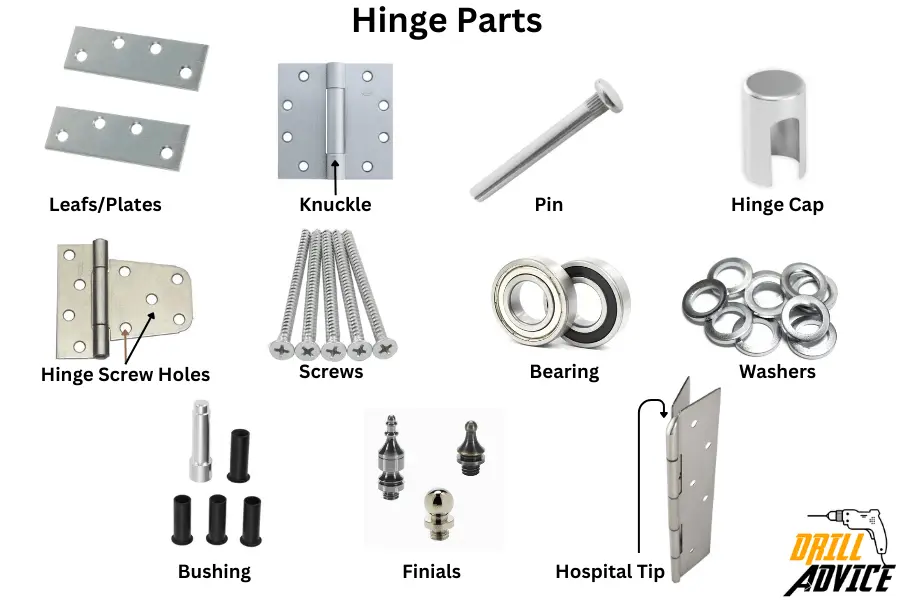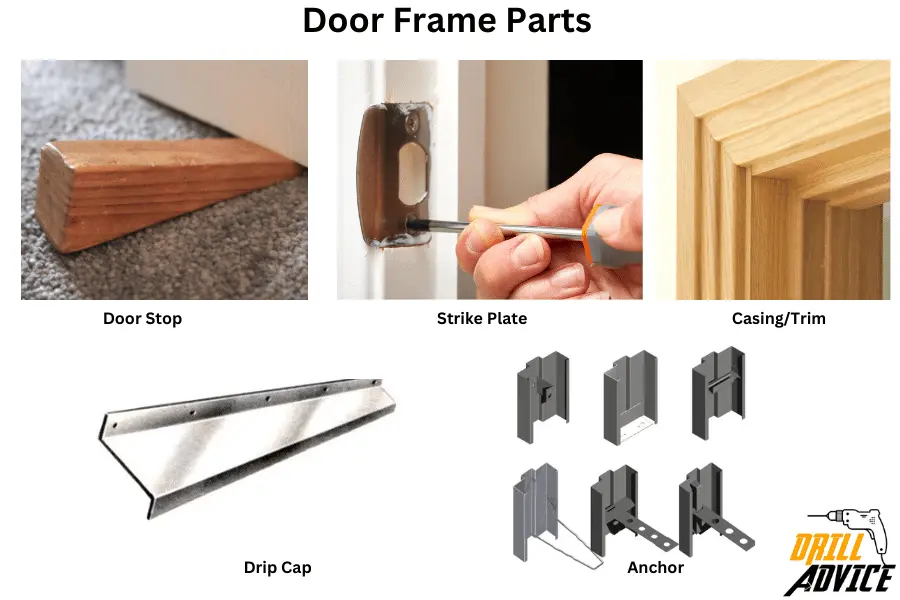
The main anatomy of the door is the handle, hinge, knob, and frame. These parts are important for door manufacturing, maintenance, and repairs. These parts are made with different types of material, and each part has a specific task.
Door should be well maintained and clean in order to keep good condition and smooth operations of each door part. You should do regular inspections, cleaning, lubricating, adjustments and repairs, weatherproofing, painting and finishing to the door for better operation and performance of each door part.
Main Door Parts

The main door consists of door parts that are made with different materials and mechanical parts. The door frame, panels, louvers, door stops are essential solid parts of the door. The door knob, hinges, lock, and peephole are the mechanical parts of the door.
- Frame: The outer structure that supports the door; it consists of the head, sill, and jambs.
- Door Panel: The main, central part of the door, which can be made of various materials like wood, steel, or fiberglass.
- Slats/Louvers: Horizontal wooden or metal blades placed at an angle in louvred doors to allow light and air to pass through.
- Hinges: The hardware used to hang the door to the frame and allow it to swing open and closed.
- Handle/Knob: A hardware component is attached to the door panel for opening and closing the door.
- Lock: A mechanism, usually accompanied by a key or knob, to secure the door.
- Threshold: The bottom part of the frame, it provides a seal for the door and often supports the door’s weight.
- Doorstop: A strip of wood or metal that helps to stop the door from swinging too far or causing damage.
- Peephole: (If applicable) A small hole or lens installed in the door to see outside without opening the door.
- Tracks: In the case of bi-fold doors, a track at the top (and sometimes at the bottom) to guide and hold the door panels as they are folded open or closed.
- Bifold Hardware: Additional hardware like pivot brackets and aligners to facilitate the folding mechanism of bi-fold doors.
Door Handle Parts

The door handle is one of the mechanical part of the door. It helps to operate the door open and close. Door handle is made with different types of material. Below are the most common parts of the door handle.
- Handle or Grip: The part that is grasped to operate the door handle. It can come in various styles and shapes.
- Spindle: A bar that passes through the door and connects the handle or knob on each side, allowing the door to be operated from both sides.
- Rose or Rosette: A decorative plate that surrounds the base of the handle, covering the mounting hardware and providing a polished finish.
- Escutcheon: An optional protective or decorative plate that surrounds the keyhole or locking mechanism.
- Thumb Turn: A small lever present in locking door handles, which allows the user to lock and unlock the door from one side.
- Latch or Bolt: A metal piece that extends from the door into the frame, holding the door closed. This can be operated by turning the handle or knob.
- Lock Cylinder: In handles with integrated lock systems, this part contains the pins, springs, and other components that work with a key to lock or unlock the door.
- Strike Plate: A metal plate attached to the door frame, which works with the latch or bolt to hold the door closed securely.
- Set Screw: A screw that holds the handle securely onto the spindle, preventing it from coming off during operation.
- Return Spring: A spring mechanism that returns the handle to a horizontal position after being turned.
- Mounting Screws: Screws that are used to fix the handle and other components onto the door.
- Keyhole: In handles with integrated locks, a hole to insert the key for locking or unlocking the door.
Door Hinge Parts

The door hinge is a hardware component that helps to hang the door and operate is open and close. Door hinges have made using different types of materials and mechanisms. 15 types of door hinges are available with different functional and installation methods of the door.
- Leafs/Plates: These are flat components that are fastened to the door and the door frame. In a typical hinge, there are two leaves connected by a pin.
- Knuckles: These are the loops or cylindrical sections where the hinge pin passes through, allowing for the rotation of the hinge.
- Pin: This is a long rod that goes through the knuckles of both leaves, holding them together and allowing for rotational movement.
- Hinge Cap: It is the top part of the hinge pin, which is often rounded or flat and prevents the pin from sliding out.
- Hinge Screw Holes: These are the holes present in the leaves, where screws are inserted to secure the hinge onto the door and the frame.
- Screws: Fasteners used to secure the hinge leaves onto the door and the door frame.
- Bearing: In heavy-duty hinges, bearings are used between the knuckles to reduce friction and ensure smooth operation.
- Washers: These are thin plates with holes that are placed between the knuckle joints to reduce friction during the hinge operation (mostly seen in heavy-duty applications).
- Bushing: Sometimes found in heavy-duty hinges, it is a type of bearing placed between the knuckles to reduce friction and wear.
- Finials: Decorative elements that can be screwed onto the ends of the hinge pin, adding an aesthetic touch to the hinge (mostly seen in residential applications).
- Hospital Tip: In specific settings, the tip of the hinge may be designed to slope in a manner that prevents it from being used as a ligature point (common in healthcare settings).
Door Lock Parts

A door lock is a complex part in the door. The door lock is made with different materials. Door lock can be operated by using a key. The main functions of the door lock are lock and unlock. Below are the most common parts of the door lock.
- Cylinder: This is the part of the lock where the key is inserted. It contains pins and springs which interact with the key to lock or unlock the mechanism.
- Deadbolt: This is a type of locking mechanism where a bolt is moved by turning a knob or key without the use of a spring.
- Latch: This bolt is spring-loaded and engages automatically when the door is closed, keeping the door in place.
- Strike Plate: This is a metal plate attached to the door frame into which the deadbolt or latch extends to secure the door.
- Faceplate: This is a flat piece that surrounds the sides of the lock mechanism, providing a clean finish and helping to protect the lock from wear.
- Spindle: In knob or handle locks, this is a piece that connects the knob or handle to the locking mechanism, allowing the lock to be operated by turning the knob or handle.
- Rosette: A decorative plate, usually circular, that surrounds the outer part of the lock, offering an aesthetically pleasing finish.
- Tailpiece: This is a part that extends from the cylinder and connects to the bolt or latch mechanism, allowing the cylinder to operate the bolt or latch.
- Cam: This is a piece of the lock mechanism that interacts with the tailpiece, allowing the lock to be locked or unlocked using a key.
- Keys: These are tools with unique patterns of cuts or grooves, which align with the pins in the cylinder, allowing the lock to be operated.
- Thumbturn: A component inside the door, which allows the user to manually lock or unlock the door from one side without a key.
- Keyway: The part of the lock cylinder where the key is inserted, which guides the key into the correct position in the cylinder.
- Housing: The body or casing that encloses the parts of the lock mechanism.
- Bolt Hub: A component that connects the bolt or latch with other parts of the lock mechanism, allowing the bolt or latch to be operated by turning a key or knob.
- Mounting Screws: These are screws used to attach the lock to the door and hold it in place.
Note that the exact parts and their names can vary depending on the specific type and brand of door lock.
Door Frame Parts

A door frame is the outer support structure of the door. The door frame helps to facilitate proper function and security to the door. The door frame is made of different materials. The door frame is designed according to the strength requirement of the door.
- Head/Jamb Top: This is the horizontal piece that forms the top of the door frame.
- Side Jambs: These are the vertical pieces on either side of the door frame that run from the floor to the head/jamb top.
- Sill/Threshold: Located at the bottom of the frame, this part provides a foundation for the frame and a seal against air and water infiltration. (Note: This is more common in exterior door frames.)
- Door Stop: This is a strip of wood or metal attached to the jambs and head, which prevents the door from swinging too far inward or outward.
- Strike Plate: This is a metal plate fixed on the side jamb, where the door lock bolt/latch extends into, providing a secure closure.
- Mullion: In frames with double doors, a mullion is a vertical element that divides the two doors, providing support and a latch point.
- Weather Stripping: Door weatherstripping is an exterior frame. It is a material around the sides and top of the frame to seal gaps and prevent air and water from entering.
- Casing/Trim: This is a decorative molding that covers the space between the wall and the frame, providing a finished appearance.
- Corner Blocks: These are decorative blocks placed at the corners where the head meets the side jambs, adding a decorative element to the frame (optional).
- Drip Cap: Installed atop exterior door frames, it helps in directing water away from the top of the door, preventing water infiltration (optional).
- Lite Frame: In frames with lites (glass panes), this is the framework that holds the glass in place within the door frame (if applicable).
- Sub Frame: This is a secondary frame that provides additional support and stability to the main door frame, especially in heavy or oversized doors (if applicable).
- Anchor: These are devices or mechanisms used to secure the door frame to the surrounding wall structure, ensuring stability and security.
- Plinth Block: A thicker block at the bottom of the casing, serving as a transition between the door casing and the baseboard, offering a decorative touch (optional).
How to Maintain a Door Properly?
1. Regular inspect the door condition
- Inspect the Door Surface: Periodically check for signs of wear, damages, or warping the door.
- Check the Hardware: Inspect the door handles, locks, hinges, and other hardware for any signs of wear or damage.
- Inspect the Seals: Check the weather stripping and seals of the door for any cracks, gaps, or wear.
2. Clean the door
- Clean the Door: Clean the door surface with appropriate cleaning agents.
- Glass Panels: If the door has glass panels, clean them with a glass cleaner to remove dirt and fingerprints.
- Clean the Hardware: Clean the door handles, locks, and other hardware using a suitable cleaning solution.
3. Lubricate the door hinges and latches
- Lubricate Hinges: Apply a lubricant to the hinges periodically to ensure smooth operation and prevent squeaking.
- Locks and Latches: Lubricate locks and latches to ensure they operate smoothly.
4. Adjust and repair necessary parts
- Adjust Hinges: If the door is sagging or not aligning properly, adjust the hinges to correct the position.
- Fix Loose Screws: Tighten any loose screws in the door hinges, handles, or other hardware.
- Repair Damage: Repair any damage to the door surface, such as cracks or holes, to prevent further deterioration.
5. Weatherproof the door
- Weather Stripping: Replace worn weather stripping to maintain a good seal around the door.
- Apply Sealant: Apply a sealant to protect the door from water and moisture damage (particularly for wooden doors).
6. Paint the door with protective paint
- Paint/Finish: Refresh the paint or finish to protect the door material and enhance its appearance.
- Varnish: For wooden doors, apply a coat of varnish to protect the wood and maintain its look.
